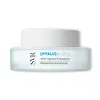What's inside
What's inside
 Key Ingredients
Key Ingredients

 Benefits
Benefits

 Concerns
Concerns

 Ingredients Side-by-side
Ingredients Side-by-side

Water
Skin ConditioningGlyceryl Stearate
EmollientHydrogenated Polydecene
EmollientVitis Vinifera Seed Oil
EmollientPropylene Glycol
HumectantStearic Acid
CleansingPalmitic Acid
EmollientSqualane
EmollientHydrogenated Vegetable Oil
EmollientPersea Gratissima Oil
Skin ConditioningCentella Asiatica Leaf Extract
Skin ConditioningAlgin
MaskingGlycine Soja Oil
EmollientTriethanolamine
BufferingAllantoin
Skin ConditioningCetyl Palmitate
EmollientEthylhexylglycerin
Skin ConditioningCaprylyl Glycol
EmollientTocopheryl Acetate
AntioxidantDisodium EDTA
Retinyl Palmitate
Skin ConditioningPhenethyl Alcohol
MaskingTocopherol
AntioxidantParfum
MaskingWater, Glyceryl Stearate, Hydrogenated Polydecene, Vitis Vinifera Seed Oil, Propylene Glycol, Stearic Acid, Palmitic Acid, Squalane, Hydrogenated Vegetable Oil, Persea Gratissima Oil, Centella Asiatica Leaf Extract, Algin, Glycine Soja Oil, Triethanolamine, Allantoin, Cetyl Palmitate, Ethylhexylglycerin, Caprylyl Glycol, Tocopheryl Acetate, Disodium EDTA, Retinyl Palmitate, Phenethyl Alcohol, Tocopherol, Parfum
Water
Skin ConditioningButylene Glycol
HumectantGlycerin
HumectantPropylene Glycol
HumectantCaprylic/Capric Triglyceride
MaskingAscorbyl Tetraisopalmitate
Antioxidant1,2-Hexanediol
Skin ConditioningC10-18 Triglycerides
EmollientCarbomer
Emulsion StabilisingMaltodextrin
AbsorbentSodium Hyaluronate
HumectantSodium Acrylates Copolymer
Acrylates/C10-30 Alkyl Acrylate Crosspolymer
Emulsion StabilisingCaprylyl Glycol
EmollientParfum
MaskingSodium Hydroxide
BufferingLecithin
EmollientLactobacillus Ferment
Skin ConditioningPentaerythrityl Tetra-Di-T-Butyl Hydroxyhydrocinnamate
AntioxidantSodium Acetylated Hyaluronate
HumectantWater, Butylene Glycol, Glycerin, Propylene Glycol, Caprylic/Capric Triglyceride, Ascorbyl Tetraisopalmitate, 1,2-Hexanediol, C10-18 Triglycerides, Carbomer, Maltodextrin, Sodium Hyaluronate, Sodium Acrylates Copolymer, Acrylates/C10-30 Alkyl Acrylate Crosspolymer, Caprylyl Glycol, Parfum, Sodium Hydroxide, Lecithin, Lactobacillus Ferment, Pentaerythrityl Tetra-Di-T-Butyl Hydroxyhydrocinnamate, Sodium Acetylated Hyaluronate
Ingredients Explained
These ingredients are found in both products.
Ingredients higher up in an ingredient list are typically present in a larger amount.
Caprylyl Glycol is a humectant and emollient, meaning it attracts and preserves moisture.
It is a common ingredient in many products, especially those designed to hydrate skin. The primary benefits are retaining moisture, skin softening, and promoting a healthy skin barrier.
Though Caprylyl Glycol is an alcohol derived from fatty acids, it is not the kind that can dry out skin.
This ingredient is also used as a preservative to extend the life of products. It has slight antimicrobial properties.
Learn more about Caprylyl GlycolParfum is a catch-all term for an ingredient or more that is used to give a scent to products.
Also called "fragrance", this ingredient can be a blend of hundreds of chemicals or plant oils. This means every product with "fragrance" or "parfum" in the ingredients list is a different mixture.
For instance, Habanolide is a proprietary trade name for a specific aroma chemical. When used as a fragrance ingredient in cosmetics, most aroma chemicals fall under the broad labeling category of “FRAGRANCE” or “PARFUM” according to EU and US regulations.
The term 'parfum' or 'fragrance' is not regulated in many countries. In many cases, it is up to the brand to define this term.
For instance, many brands choose to label themselves as "fragrance-free" because they are not using synthetic fragrances. However, their products may still contain ingredients such as essential oils that are considered a fragrance by INCI standards.
One example is Calendula flower extract. Calendula is an essential oil that still imparts a scent or 'fragrance'.
Depending on the blend, the ingredients in the mixture can cause allergies and sensitivities on the skin. Some ingredients that are known EU allergens include linalool and citronellol.
Parfum can also be used to mask or cover an unpleasant scent.
The bottom line is: not all fragrances/parfum/ingredients are created equally. If you are worried about fragrances, we recommend taking a closer look at an ingredient. And of course, we always recommend speaking with a professional.
Learn more about ParfumPropylene Glycol is an odorless, colorless liquid. As a humectant, it helps skin retain moisture. It also aids in delivering active ingredients.
Another role of this ingredient is preventing a product from melting or freezing. Propylene glycol also adds antimicrobrial properties to a product, elongating product lifespan.
This ingredient is considered an organic alcohol and commonly added into both cosmetics and foods.
Those with sensitive skin or conditions may develop a rash when using this ingredient.
Learn more about Propylene GlycolWater. It's the most common cosmetic ingredient of all. You'll usually see it at the top of ingredient lists, meaning that it makes up the largest part of the product.
So why is it so popular? Water most often acts as a solvent - this means that it helps dissolve other ingredients into the formulation.
You'll also recognize water as that liquid we all need to stay alive. If you see this, drink a glass of water. Stay hydrated!
Learn more about Water